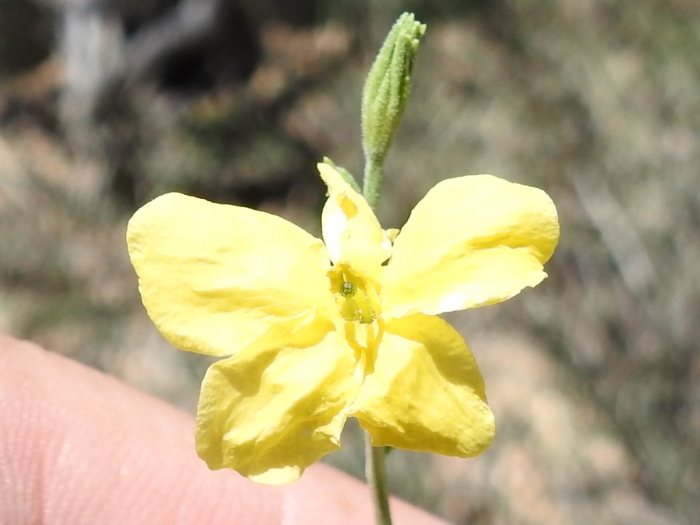Rough Menodora
(Menodora scabra)
Rough Menodora (Menodora scabra)
/
/

Sam Kieschnick
CC BY 4.0
Image By:
Sam Kieschnick
Recorded By:
Copyright:
CC BY 4.0
Copyright Notice:
Photo by: Sam Kieschnick | License Type: CC BY 4.0 | License URL: http://creativecommons.org/licenses/by/4.0/ | Rights Holder: Sam Kieschnick | Publisher: iNaturalist | Date Created: 2017-08-27T01:09:06-07:00 |



















































Estimated Native Range
Summary
Menodora scabra, commonly known as Rough Menodora, is an evergreen perennial subshrub or herb native to arid regions, including desert scrub, chaparral, and open woodlands in the Southwestern United States and Northwest Mexico. It typically grows to a modest size, with multiple upright stems reaching no more than 30 centimeters tall. The plant is characterized by its rough hairs and short, woolly fibers, which help it conserve moisture. Its leaves are oblong or oval, smooth along the edges, and alternately arranged, providing a dense foliage. The inflorescence is a loose cluster of bright yellow flowers at the tip of a stem branch, blooming from late spring to early fall. The flowers are modestly showy, with a corolla of 4 to 6 lobes and prominent stamens and stigma. Following flowering, it produces a fruit capsule containing seeds.
Rough Menodora is valued for its drought tolerance and ability to thrive in harsh conditions, making it an excellent choice for xeriscaping and desert gardens. It is also appreciated for its bright yellow flowers that add a splash of color to arid landscapes. This plant is well-suited for rock gardens, border fronts, and as ground cover. It requires minimal maintenance, needing only full sun exposure and well-drained soils. While it tolerates low water conditions, occasional watering during prolonged dry spells can keep it looking its best. It is not known for having significant disease or pest problems, but it can be sensitive to overwatering, which may lead to root rot.CC BY-SA 4.0
Rough Menodora is valued for its drought tolerance and ability to thrive in harsh conditions, making it an excellent choice for xeriscaping and desert gardens. It is also appreciated for its bright yellow flowers that add a splash of color to arid landscapes. This plant is well-suited for rock gardens, border fronts, and as ground cover. It requires minimal maintenance, needing only full sun exposure and well-drained soils. While it tolerates low water conditions, occasional watering during prolonged dry spells can keep it looking its best. It is not known for having significant disease or pest problems, but it can be sensitive to overwatering, which may lead to root rot.CC BY-SA 4.0
Plant Description
- Plant Type: Subshrub, Herb
- Height: 1-2.5 feet
- Width: 0.4-1 feet
- Growth Rate: Rapid
- Flower Color: Yellow
- Flowering Season: Summer, Fall
- Leaf Retention: Evergreen
Growth Requirements
- Sun: Full Sun
- Water: Low
- Drainage: Medium, Fast
Common Uses
Drought Tolerant, Low Maintenance, Rock Garden, Showy Flowers
Natural Habitat
Desert scrub, chaparral, and open woodlands
Other Names
Common Names: Broom Twinberry
Scientific Names: , Menodora scabra, Menodora laevis, Menodora scoparia, Menodora scabra var. glabrescens, Menodora scabra var. scabra, Menodora scabra var. laevis, Menodora scabra var. ramosissima, Menodora decemfida var. longifolia, Menodora scabra var. longituba,
GBIF Accepted Name: Menodora scabra Engelm. ex A.Gray